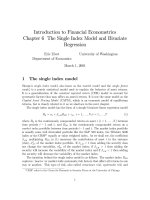Lecture Undergraduate econometrics - Chapter 8: The multiple regression model
Bạn đang xem bản rút gọn của tài liệu. Xem và tải ngay bản đầy đủ của tài liệu tại đây (221.27 KB, 73 trang )
Chapter 8
The Multiple Regression Model: Hypothesis Tests and the Use of Nonsample
Information
• An important new development that we encounter in this chapter is using the Fdistribution to simultaneously test a null hypothesis consisting of two or more
hypotheses about the parameters in the multiple regression model.
• The theories that economists develop also sometimes provide nonsample information
that can be used along with the information in a sample of data to estimate the
parameters of a regression model.
• A procedure that combines these two types of information is called restricted least
squares.
• It can be a useful technique when the data are not information-rich, a condition called
collinearity, and the theoretical information is good. The restricted least squares
Slide 8.1
Undergraduate Econometrics, 2nd Edition-Chapter 8
procedure also plays a useful practical role when testing hypotheses. In addition to
these topics we discuss model specification for the multiple regression model and the
construction of “prediction” intervals.
• In this chapter we adopt assumptions MR1-MR6, including normality, listed on page
150. If the errors are not normal, then the results presented in this chapter will hold
approximately if the sample is large.
• What we discover in this chapter is that a single null hypothesis that may involve one
or more parameters can be tested via a t-test or an F-test. Both are equivalent. A joint
null hypothesis, that involves a set of hypotheses, is tested via an F-test.
Slide 8.2
Undergraduate Econometrics, 2nd Edition-Chapter 8
8.1 The F-Test
• The F-test for a set of hypotheses is based on a comparison of the sum of squared
errors from the original, unrestricted multiple regression model to the sum of squared
errors from a regression model in which the null hypothesis is assumed to be true.
• To illustrate what is meant by an unrestricted multiple regression model and a model
that is restricted by the null hypothesis, consider the Bay Area Rapid Food hamburger
chain example where weekly total revenue of the chain (tr) is a function of a price
index of all products sold (p) and weekly expenditure on advertising (a).
trt = β1 + β2pt + β3at + et
(8.1.1)
• Suppose that we wish to test the hypothesis that changes in price have no effect on
total
revenue
against
the
alternative
that
price
does
have
an
effect.
Slide 8.3
Undergraduate Econometrics, 2nd Edition-Chapter 8
The null and alternative hypotheses are: H0: β2 = 0 and H1: β2 ≠ 0. The restricted
model, that assumes the null hypothesis is true, is
trt = β1 + β3at + et
(8.1.2)
Setting β2 = 0 in the unrestricted model in Equation (8.1.1) means that the price
variable Pt does not appear in the restricted model in Equation (8.1.2).
• When a null hypothesis is assumed to be true, we place conditions, or constraints, on
the values that the parameters can take, and the sum of squared errors increases. Thus,
the sum of squared errors from Equation (8.1.2) will be larger than that from Equation
(8.1.1).
Slide 8.4
Undergraduate Econometrics, 2nd Edition-Chapter 8
• The idea of the F-test is that if these sums of squared errors are substantially different,
then the assumption that the null hypothesis is true has significantly reduced the ability
of the model to fit the data, and thus the data do not support the null hypothesis.
• If the null hypothesis is true, we expect that the data are compatible with the
conditions placed on the parameters. Thus, we expect little change in the sum of
squared errors when the null hypothesis is true.
• We call the sum of squared errors in the model that assumes a null hypothesis to be
true the restricted sum of squared errors, or SSER, where the subscript R indicates that
the parameters have been restricted or constrained.
• The sum of squared errors from the original model is the unrestricted sum of squared
errors, or SSEU. It is always true that SSER − SSEU ≥ 0. Recall from Equation (6.1.7)
that
Slide 8.5
Undergraduate Econometrics, 2nd Edition-Chapter 8
R2 =
SSR
SSE
= 1−
SST
SST
• Let J be the number of hypotheses. The general F-statistic is given by
F=
( SSER − SSEU ) J
SSEU (T − K )
(8.1.3)
If the null hypothesis is true, then the statistic F has an F-distribution with J numerator
degrees of freedom and T − K denominator degrees of freedom.
• If the null hypothesis is not true, then the difference between SSER and SSEU becomes
large, implying that the constraints placed on the model by the null hypothesis have a
large effect on the ability of the model to fit the data. If the difference SSER − SSEU is
Slide 8.6
Undergraduate Econometrics, 2nd Edition-Chapter 8
large, the value of F tends to be large. Thus, we reject the null hypothesis if the value
of the F-test statistic becomes too large.
• We compare the value of F to a critical value Fc which leaves a probability α in the
upper tail of the F-distribution with J and T − K degrees of freedom. The critical
value for the F-distribution is depicted in Figure 8.1. Tables of critical values for α =
.01 and α = .05 are provided at the end of the book (Tables 3 and 4).
• For the unrestricted and restricted models in Equations (8.1.1) and (8.1.2),
respectively, we find
SSEU = 1805.168
SSER = 1964.758
By imposing the null hypothesis H0: β2 = 0 on the model the sum of squared errors has
increased from 1805.168 to 1964.758.
• There is a single hypothesis, so J = 1 and the F-test statistic is:
Slide 8.7
Undergraduate Econometrics, 2nd Edition-Chapter 8
SSER − SSEU ) J (1964.758 − 1805.168 ) 1
(
F=
=
SSEU (T − K )
1805.168 ( 52 − 3)
= 4.332
• We compare this value to the critical value from an F-distribution with 1 and 49
degrees of freedom. For the F(1, 49) distribution the α = .05 critical value is Fc = 4.038.
Since F = 4.332 ≥ Fc we reject the null hypothesis and conclude that price does have a
significant effect on total revenue. The p-value for this test is p = P[F(1, 49) ≥ 4.332] =
.0427, which is less than α = .05, and thus we reject the null hypothesis on this basis
as well.
• The p-value can also be obtained using modern software such as EViews. See Table
8.1.
• Recall that we used a t-test to test H0: β2 = 0 against H1: β2 ≠ 0 in Chapter 7. Indeed,
in Table 7.2 the p-value for this t-test is 0.0427, the same as the p-value for the F-test
that we just considered.
Slide 8.8
Undergraduate Econometrics, 2nd Edition-Chapter 8
• When testing one “equality” null hypothesis against a “not equal to” alternative
hypothesis, either a t-test or an F-test can be used and the outcomes will be identical.
• The reason for this is that there is an exact relationship between the t- and Fdistributions. The square of a t random variable with df degrees of freedom is an F
random variable with distribution F(1, df).
• When using a t-test for H0: β2 = 0 against H1: β2 ≠ 0, we found that t = –2.081, tc =
2.01, and p = .0427. The F-value that we have calculated is F = 4.332 = t2 and Fc =
(tc)2. Because of this exact relationship, the p-values for the two tests are identical,
meaning that we will always reach the same conclusion whichever approach we take.
There is no equivalence when using a one-tailed t-test since the F-test is not
appropriate when the alternative is an inequality, “>” or “<.”
• We can summarize the elements of an F-test as follows:
Slide 8.9
Undergraduate Econometrics, 2nd Edition-Chapter 8
1. The null hypothesis H0 consists of one or more (J) equality hypotheses. The null
hypothesis may not include any “greater than or equal to” or “less than or equal to”
hypotheses.
2. The alternative hypothesis states that one or more of the equalities in the null
hypothesis is not true. The alternative hypothesis may not include any “greater
than” or “less than” options.
3. The test statistic is the F-statistic in Equation (8.1.3).
4. If the null hypothesis is true, F has the F-distribution with J numerator degrees of
freedom and T − K denominator degrees of freedom.
The null hypothesis is
rejected if F ≥ Fc, where Fc is the critical value that leaves α% of the probability in
the upper tail of the F-distribution.
5. When testing a single equality hypothesis it is perfectly correct to use either the tor F-test procedure. They are equivalent. In practice, it is customary to test single
hypothesis using a t-test. The F-test is usually reserved for joint hypotheses.
Slide 8.10
Undergraduate Econometrics, 2nd Edition-Chapter 8
8.1.1 The F-Distribution: Theory
An F random variable is formed by the ratio of two independent chi-square random
variables that have been divided by their degrees of freedom.
If V1 ~ χ(2m1 ) and V2 ~ χ(2m2 ) and if V1 and V2 are independent, then
V1
F=
V2
m1
~ F( m1 , m2 )
(8.1.4)
m2
• The F-distribution is said to have m1 numerator degrees of freedom and m2
denominator degrees of freedom. The values of m1 and m2 determine the shape of the
distribution, which in general looks like Figure 8.1. The range of the random variable
is (0, ∞) and it has a long tail to the right.
• When you take advanced courses in econometric theory, you prove that
Slide 8.11
Undergraduate Econometrics, 2nd Edition-Chapter 8
V1 =
SSER − SSEU
~ χ(2J )
2
σ
(8.1.5)
SSEU
~ χ(2T − K )
2
σ
(8.1.6)
V2 =
and that V1 and V2 are independent. The result for V1 requires the relevant null
hypothesis to be true; that for V2 does not. Note that σ2 cancels when we take the ratio
of V1 to V2, yielding
F=
( SSER − SSEU ) J
V1 J
=
V2 (T − K )
SSEU (T − K )
(8.1.7)
Slide 8.12
Undergraduate Econometrics, 2nd Edition-Chapter 8
The Chi-square statistic given in the EViews output in Table 8.1 is equal to V1 with σ2
replaced by σˆ 2. It is a large-sample approximation which you will learn more about in
advanced courses.
Table 8.1 EViews Output for Testing Price Coefficient
Null
C(2) = 0
Hypothesis:
F-statistic
4.331940
Probability
0.042651
Chi-square
4.331940
Probability
0.037404
Slide 8.13
Undergraduate Econometrics, 2nd Edition-Chapter 8
8.2 Testing the Significance of a Model
• An important application of the F-test is for what is called “testing the overall
significance of a model.” Consider again the general multiple regression model with
(K − 1) explanatory variables and K unknown coefficients
yt = β1 + β2xt2 + β3xt3 +…+ βK xtK + et
(8.2.1)
• To examine whether we have a viable explanatory model, we set up the following null
and alternative hypotheses
H0: β2 = 0, β3 = 0,…, βK = 0
(8.2.2)
H1: at least one of the βK is nonzero
Slide 8.14
Undergraduate Econometrics, 2nd Edition-Chapter 8
• The null hypothesis has K − 1 parts, and it is called a joint hypothesis. It states as a
conjecture that each and every one of the parameters βK, other than the intercept
parameter β1, is zero.
• If this null hypothesis is true, none of the explanatory variables influence y, and thus
our model is of little or no value. If the alternative hypothesis H1 is true, then at least
one of the parameters is not zero. The alternative hypothesis does not indicate,
however, which variables those might be.
• Since we are testing whether or not we have a viable explanatory model, the test for
Equation (8.2.2) is sometimes referred to as a test of the overall significance of the
regression model.
• The unrestricted model is that given in Equation (8.2.1).
• To test the joint null hypothesis H0: β2 = β3 =…= βK = 0, which actually is K − 1
hypotheses, we will use a test based on the F-distribution.
Slide 8.15
Undergraduate Econometrics, 2nd Edition-Chapter 8
• If the joint null hypothesis H0: β2 = 0, β3 = 0,…, βK = 0 is true, then the restricted
model is
yt = β1 + et
(8.2.3)
• The least squares estimator of β1 in this restricted model is b
*
1
y
∑
=
t
T
= y , which is the
sample mean of the observations on the dependent variable.
• The restricted sum of squared errors from the hypothesis (8.2.2) is
SSER = ∑ ( yt − b1* ) 2 =∑ ( yt − y ) 2 = SST
• In this one case, in which we are testing the null hypothesis that all the model
parameters are zero except the intercept, the restricted sum of squared errors is the
Slide 8.16
Undergraduate Econometrics, 2nd Edition-Chapter 8
total sum of squares (SST) from the full unconstrained model. The unrestricted sum of
squared errors is the sum of squared errors from the unconstrained model, or SSEU =
SSE. The number of hypotheses is J = K − 1. Thus to test the overall significance of a
model the F-test statistic can be modified as
F=
( SST − SSE ) /( K − 1)
SSE /(T − K )
(8.2.4)
• The calculated value of this test statistic is compared to a critical value from the F(K-1,
T-K)
distribution.
• To illustrate, we test the overall significance of the regression used to explain the Bay
Area Burger’s total revenue. We want to test whether the coefficients of price and of
advertising expenditure are both zero, against the alternative that at least one of the
coefficients is not zero. Thus, in the model
Slide 8.17
Undergraduate Econometrics, 2nd Edition-Chapter 8
trt = β1 + β2pt + β3at + et
we want to test
H0: β2 = 0, β3 = 0
against the alternative
H1: β2 ≠ 0 or β3 ≠ 0, or both nonzero.
• The ingredients for this test, and the test statistic value itself, are reported in the
Analysis of Variance Table reported by most regression software. The SHAZAM
output for the Bay Area Rapid Food data appears in Table 8.2. From this table, we see
that SSER = SST = 13581 and SSEU = SSE = 1805.2.
Slide 8.18
Undergraduate Econometrics, 2nd Edition-Chapter 8
Table 8.2 ANOVA Table obtained using SHAZAM
• The values of Mean Square are the ratios of the Sums of Squares values to the degrees
of freedom, DF.
• In turn, the ratio of the Mean Squares is the F-value for the test of overall significance
of the model. For the Bay Area Burger data this calculation is
F=
( SST − SSE ) /( K − 1) (13581.35 − 1805.168) / 2 5888.09
=
=
= 159.83
SSE /(T − K )
1805.168 /(52 − 3)
36.84
Slide 8.19
Undergraduate Econometrics, 2nd Edition-Chapter 8
The 5% critical value for the F statistic with (2, 49) degrees of freedom is Fc = 3.187.
Since 159.83 > 3.187, we reject H0 and conclude that the estimated relationship is a
significant one. Instead of looking up the critical value, we could have made our
conclusion based on the p-value, which is calculated by most software, and is reported
in Table 8.2. Our sample of data suggests that price or advertising expenditure or both
have an influence on total revenue. Note that this conclusion is consistent with
conclusions reached using separate t-tests for testing the significance of price and the
significance of advertising expenditure in Chapter 7.
8.2.1 The Relationship between Joint and Individual Tests
Why use the F-distribution to perform a simultaneous test of H0: β2 = 0, β3 = 0? Why not
just use separate t-tests on each of the null hypotheses H0: β2 = 0 and H0: β3 = 0? The
answer relates to the correlation between the least squares estimators. The F-test that
Slide 8.20
Undergraduate Econometrics, 2nd Edition-Chapter 8
tests both hypotheses simultaneously makes allowance for the fact that the least squares
estimators b2 and b3 are correlated. It is a test for whether the pair of values β2 = 0 and β3
= 0 are consistent with the data. When separate t-tests are performed, the possibility that
β2 = 0 is not considered when testing H0: β3 = 0, and vice versa. It is not a pair of values
being tested with t-tests, but a consequence about a single parameter at a time. Each ttest is treated in isolation from the other, no allowance is made for the correlation
between b2 and b3. As a consequence, the joint F-test at a 5% significance level is not
equivalent to separate t-tests that each uses a 5% significance level. Conflicting results
can occur. For example, it is possible for individual t-tests to fail to conclude that
coefficients are significantly different from zero, while the F-test implies that the
coefficients are jointly significant. This situation frequently arises when the data are
collinear, as described in Section 8.7.
Slide 8.21
Undergraduate Econometrics, 2nd Edition-Chapter 8
8.3 An Extended Model
We have hypothesized so far in this chapter that total revenue at the Bay Area Rapid
Food franchise is explained by product price and advertising expenditures,
trt = β1 + β2pt + β3at + et
(8.3.1)
One aspect of this model that is worth questioning is whether the linear relationship
between revenue, price, and advertising expenditure is a good approximation to reality.
• This linear model implies that increasing advertising expenditure will continue to
increase total revenue at the same rate, irrespectively of the existing level of revenue
and advertising expenditure. That is, the coefficients β3, that measures the response of
E(tr) to a change in a, is constant.
Slide 8.22
Undergraduate Econometrics, 2nd Edition-Chapter 8
• However, as the level of advertising expenditure increases, we would expect
diminishing returns to set in.
That is, the increase in revenue that results from
advertising grows.
• One way of allowing for diminishing returns to advertising is to include the squared
value of advertising, a2, into the model as another explanatory variable, so
trt = β1 + β2 pt + β3at + β4 at2 + et
(8.3.2)
Adding the term β4 at2 to our original specification yields a model in which the
response of expected revenue to advertising depends on the level of advertising.
• The response of E(tr) to a is
∆E (trt )
∂E (trt )
=
= β3 + 2β4 at
∆at ( p held constant)
∂at
(8.3.3)
Slide 8.23
Undergraduate Econometrics, 2nd Edition-Chapter 8
When at increases by one unit ($1,000), and pt is held constant, E(tr) increases by (β3
+ 2β4at) × $1,000.
• To determine the anticipated signs for β3 and β4 we note that we would expect the
response of revenue to advertising to be positive when at = 0. That is, we expect that
β3 > 0. Also, to achieve diminishing returns the response must decline as at increases.
That is, we expect β4 < 0.
• For estimation purposes, the squared value of advertising is “just another variable.”
That is, we can write Equation (8.3.2) as
yt = β1 + β2xt2 + β3xt3 + β4xt4 + et
(8.3.4)
where yt = trt, xt2 = pt, xt3 = at, and xt3 = at2.
Slide 8.24
Undergraduate Econometrics, 2nd Edition-Chapter 8
• The least squares estimates, using the data in Table 7.1, are
ˆ t = 104.81 − 6.582 pt + 2.948at + 0.0017 at2
tr
(6.58) (3.459)
(0.786)
(0.0361)
(s.e.)
(R8.4)
What can we say about the addition of at2 to the equation? The first thing to notice is
that its coefficient is positive, not negative, as was expected. Second, its t-value for
the hypothesis H0: β4 = 0 is t = 0.0017/0.0361 = 0.048. This very low value indicates
that b4 is not significantly different from zero. If β4 is zero, there are no diminishing
returns to advertising, which is counter to our belief in the phenomenon of diminishing
returns. Thus, we conclude that β4 has been estimated imprecisely and its standard
error is too large.
• When economic parameters are estimated imprecisely, one solution is to obtain more
and better data. Recall that the variances of the least squares estimators are reduced
Slide 8.25
Undergraduate Econometrics, 2nd Edition-Chapter 8









